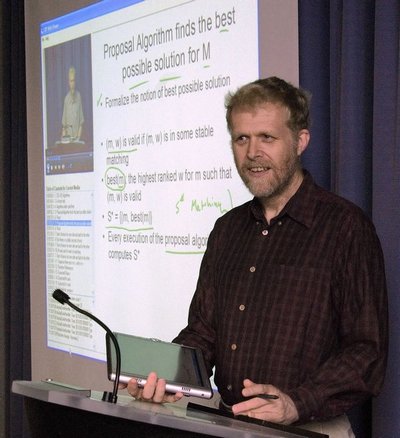July 16, 2007
Microsoft picks new UW center to develop distance learning technologies
Last year, students enrolled in a professional master’s degree program in Seattle sat 800 miles from their teacher. When the students asked questions, their teacher responded from the video screen. Discussion ricocheted between classrooms in Seattle and Redmond, Wash., and further south to San Diego and Berkeley, Calif.
The course was one of many using experimental classroom videoconferencing software developed at Microsoft Research in collaboration with universities worldwide. Microsoft Research today announced that the University of Washington will lead future work on the project in the newly established Center for Collaborative Technologies at the University of Washington. Microsoft will provide $750,000 in funding during the next three years.
“We will continue to develop technologies to support distance learning,” said center director Richard Anderson, a UW professor in the department of computer science and engineering. “This will allow us to extend the technology to use it potentially in international settings, potentially for applications in the developing world.”
Anderson has worked with Microsoft Research on distance learning since 2001.
“The University of Washington has a long history of innovation with collaborative-technology research,” said Paul Oka, a program manager at Microsoft. “Working together, we plan to bring the benefits of collaborative classrooms and highly interactive distance-learning environments to a much broader group of educators and researchers around the world.”
ConferenceXP, the videoconferencing system developed at Microsoft Research, will be the main focus for the center. It is less expensive and more flexible than commercial videoconferencing tools. The current version delivers high-quality video content almost instantly, using standard computer hardware and university campuses’ high-bandwidth Internet connections. In the test last year, standard computers relayed high-quality audio and video among four classrooms with virtually no delay.
“It’s the interaction that distinguishes this from just watching a recorded video,” Anderson said.
Lectures, slides and discussions are archived after class so that missing students can easily catch up. But the experimental software currently requires trained technicians at each of the classroom sites. Improvements will make the system easier to use and more flexible. And other expansions are in the works. Anderson plans to establish connections in the next year with classrooms in India and South America. The team will also create a simplified version of the software that doesn’t require high-bandwidth connections and could operate in remote areas in the developing world.
The UW group also is working to integrate high-definition video with a resolution up to 1,920 by 1,080 pixels. Better resolution will let teachers see individual students’ expressions. But sending high-definition video quickly will require a special Internet connection — in this case Internet2, a network linking the UW and dozens of U.S. campuses that can transmit gigabits of data per second.
“My personal hope is that high-definition video will allow instructors to interpret student facial expressions,” said Fred Videon, a UW software engineer involved in the project. “These subtle cues play a big part in the classroom, but a lot of them are lost right now due to the technology.”
Anderson and his students have spent the past five years developing an innovative tool, Classroom Presenter, which can be used with ConferenceXP. Classroom Presenter uses digital notepads, called Tablet PCs, to let instructors write on their projected slides. In his classes, Anderson has taken the project one step further by giving students their own Tablet PCs. He assigns short exercises during class that students submit over the room’s wireless network. Anderson can immediately review the students’ work, display their responses, and tailor his lecture accordingly. He believes it offers unique possibilities for distance learning.
“In our live classes, using the Tablet PC is a tremendous change because it means that I can get information from all my students simultaneously,” Anderson said. “I’m very, very interested to see it working in a distance class, because the hardest thing in distance learning is to get contributions from the remote students.”
The ConferenceXP software is a shared source project, allowing any researcher to tinker with the code and create new add-ons. Conference Presenter and ConferenceXP are both available free for download; the programs require the Windows operating system. More information and downloads are available from the UW’s Center for Collaborative Technologies Web site, http://cct.cs.washington.edu/
###
For more information, contact Anderson at (206) 543-4305 or anderson@cs.washington.edu and Oka at 857-453-6169 or paul.oka@microsoft.com.



